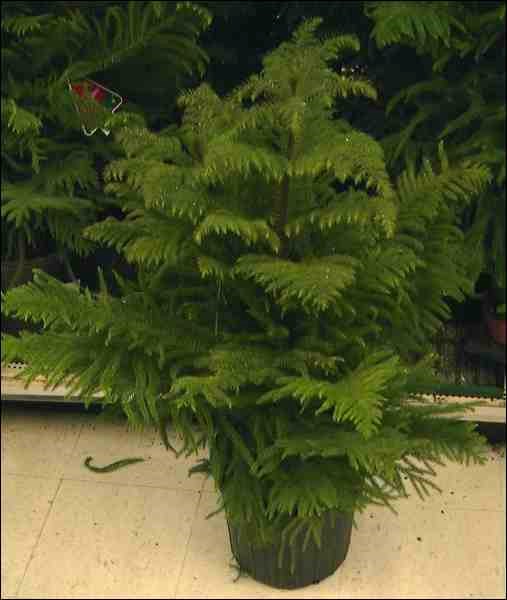Although many of its 1,800 residents trace their origins to Australia's penal colonies, Norfolk Island today is a peaceful farming community, lying 1,450 km east of Australia. Its chief claim to fame is the Norfolk Island pine (Araucaria heterophylla), which resembles a spruce, is called a pine, but is actually neither, and is instead an evergreen conifer belonging to a tropical and subtropical genus found throughout the South Pacific.
With the look of a traditional Christmas tree, Norfolk Island pines are found in garden centres and other retail outlets, especially at this time of year. A live potted evergreen, they make an excellent alternative to a cut one, and can resume their role as a houseplant once "the season" is over.
The short, slightly curved, medium green needles occur singly and densely along young stems. Branches are held straight out or slightly upward-pointing from the main trunk, but the paired side-branches, along the main branches, may be slightly weepy or droopy, especially when grown indoors. The tree is very symmetrical, forming a triangle when viewed from the side, and a many-pointed star from the top leading to its other common name, "star pine."
In its native habitat, Norfolk Island pines reach 50-65 metres, but nowhere in Canada and only a few places in the United States can they be successfully grown outdoors to maturity. Even in Florida, where most of the potted Norfolk Island pines are grown for the houseplant market, they are easily damaged by occasional frosts and all-too-frequent hurricanes. Indoors, it is slow growing with a somewhat weak trunk, often requiring support once it's over 2 metres, perhaps a good time to start afresh.
When determining ideal growing conditions for a houseplant, it's useful to look to its native outdoor environment for clues. "Subtropical" means short-sleeve temperatures. Norfolk Island pines cannot tolerate chilling or freezing, so keep them away from cold drafts from doors or windows. Also, minimize the time and protect them during transport from store to home.
Originating from a small island suggests a preference for high humidity and dependable moisture, particularly during the winter when our prairie homes are so dry. Additional moisture from humidifiers and aquariums, or by placing the pot on a gravel tray filled with water [ensuring the bottom of the pot is not in contact with water] is beneficial. "Adapted to sand," means they require well-draining potting media. Water regularly to maintain a moist but not soggy root-zone, taking care not to let the soil dry out completely.
Well-draining soil also implies that it does not require a great deal of nutrients to grow well. Translation: apply a half-strength, all-purpose houseplant fertilizer like 20-20-20 + micronutrients monthly. Finally, this is a tree found in full sunlight in its native habitat, not in the undergrowth as are many of our other houseplants. So provide lots of light: in a south-facing window during winter, and bright, indirect light in summer. Remember to turn the plant occasionally to maintain a uniform shape.
If you decide to decorate your Norfolk Island pine for Christmas, use LEDs. They give off very little heat that would otherwise dry the branches out, and they use very little energy, benefiting the environment and your power bill. Minimize other decorations to avoid damaging the tender branch tips and shading the leaves. Sometimes, less is more. Follow the advice from Coco Chanel, 20th Century fashion maven: "when accessorizing, always take off the last thing you put on."
- This column is provided by the Saskatchewan Perennial Society




